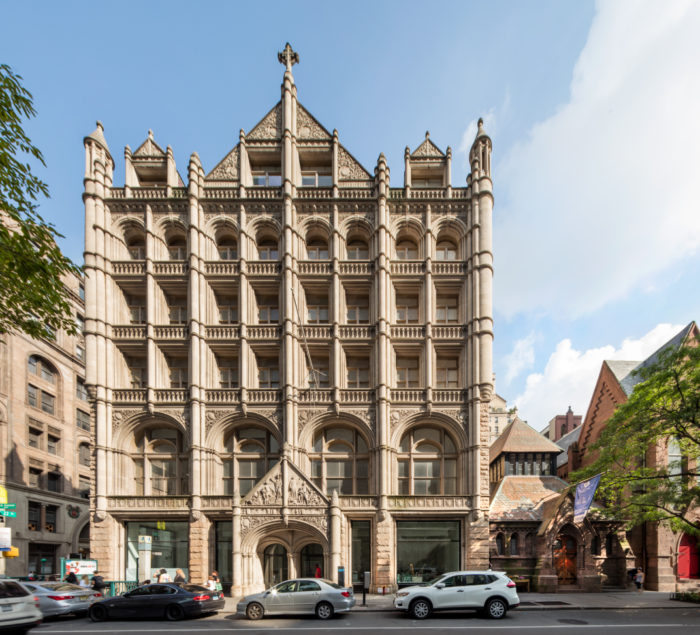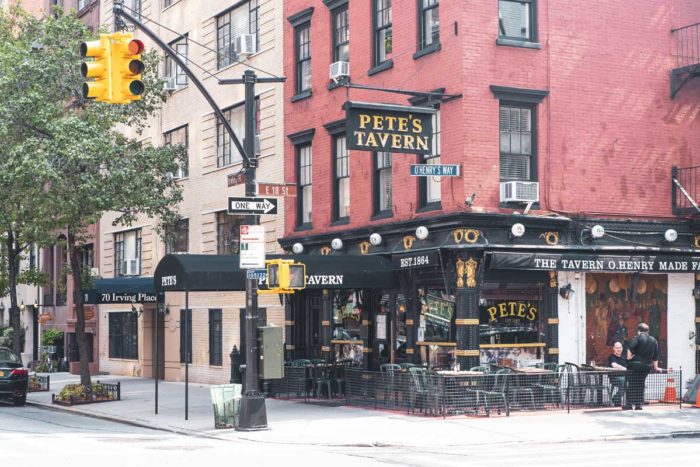A few years ago we compiled our first Landmark Tour of Gramercy, highlighting a few of the neighborhood’s structures recognized by the New York City Landmarks Preservation Commission. The neighborhood is so rich in landmarks, however, that one tour does not suffice. Below are more sites worthy of a visit.
Church Missions House
281 Park Avenue South (at East 22nd Street)

Credit: The Architect’s Newspaper
With its pink granite and terracotta facade, carved white marble tableaus and spandrels, carved frieze, steeply pitched copper roof, and dramatic columns, this seven-story building seems to have been lifted from the town center of Antwerp or Ghent. This exemplar of Flemish Revival architecture was completed in 1894 for the Domestic and Foreign Mission Society of the Episcopal Church; Cornelius Vanderbilt and J. Pierpont Morgan were among those who donated land and money to fund the enterprise at a time when this swatch of Park Avenue South was becoming known as Charity Row. Today the building is home to the New York branch of photography museum Fotografiska.
The Players Club
16 Gramercy Park South (between Irving Place and Park Avenue South)
Prior to 1865, Edwin Booth was best known as a groundbreaking Shakespearean actor. After April of that year, however, he was more infamous as the elder brother of Abraham Lincoln’s assassin, John Wilkes Booth. As part of his efforts to restore the luster to his family name, he founded the Players Club in 1888 to promote “social intercourse” between actors and the artists, musicians, writers, and arts patrons who often looked down upon them. He had one of the era’s best-known architects, Stanford White, transform the 1847 Greek Revival residence into a stately clubhouse. Mark Twain and General William Tecumseh Sherman were among the founding members; actors José Ferrer, Lynn Redgrave, and Timothy Hutton were among the club’s presidents; and the Actors Equity union was born here. The interior includes a bar, a restaurant, antique costumes and playbills, an elevator in which Sarah Bernhardt was stuck for more than an hour, and the room where Edwin Booth lived and died (along with the skull that Booth used in his performances of Hamlet’s “to be or not to be” soliloquy—it was that of a fan who had willed it to him). Unfortunately you cannot access the interior unless you are a Players Club member or a guest. You can, however, admire the striking balconied exterior, which includes two of the city’s few remaining 19th-century gaslights.
Brotherhood Synagogue
28 Gramercy Park South (between Third Avenue and Irving Place)
Clad in limestone and light brick, what is now the Brotherhood Synagogue was built in 1859 as a Quaker meeting house, which accounts for its lack of ornamentation. During the Civil War, when it was still known as the 20th Street Meeting House, it served as a stop on the Underground Railroad; escaped slaves were hidden on the second floor, and the tunnel beneath the building is still accessible today. Declining membership led the Quaker congregation to merge with that of the Stuyvesant Square meeting house in 1858. The Brotherhood congregation bought the building in 1974 and retained many of the original features, including the pews.
Pete’s Tavern
129 East 18th Street (at Irving Place)

This Manhattan institution is not technically a New York City Landmark, but it is part of the Gramercy Park Historic District—and besides, who does not like ending a walking tour in a pub? Dating back to 1829, the five-story red-brick building was originally a hotel. The ground floor then became the 19th-century version of a convenience store before becoming a tavern in 1864. It was known as Healy’s Café when O. Henry, who lived on Irving Place, wrote his most famous short story, “The Gift of the Magi,” in 1905. Legend has it that he penned the story while in his usual booth, the second from the front door. The bar became known as Pete’s when Peter Belles bought it in 1926. This was in the midst of Prohibition, so the establishment was ostensibly a flower shop, but regulars knew to slip behind the flower refrigerator to get to the speakeasy. After 1929, many of those regulars included the politicos who frequented the new Tammany Hall a few blocks away. Much of Pete’s Tavern’s interior, including the tin ceiling, the tiled floor, and the rosewood bar, have remained unchanged for more than 150 years.
A Landmark Tour of Gramercy, Part 2


